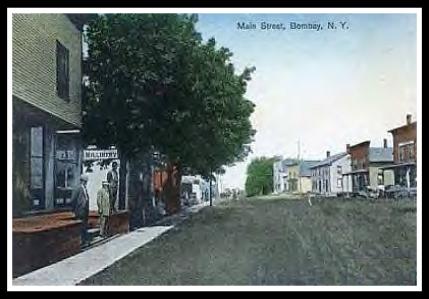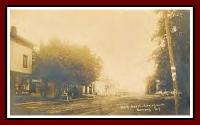A short history of Bombay NY from a book written about Franklin County in 1918.
A short history of Bombay NY from a book written about Franklin County in 1918. Our branch of the Jesmer family farmed in between Hogansburg and Bombay, Upper State New York. The moved, en mass, near Princeton Minnesota around 1867. The picture is downtown Bombay in 1910.
Link to Joseph A. Jesmer and Mary Ann (Robideau) Jesmer
Link to Joseph’s parents: Joseph and Julia (Plamondon) Jesmer



Most of the pioneers (Bombay area) – merchants, millers, farmers and teachers – were men of energy, enterprise and rugged character, and nearly every one named had a noteworthy part in the town’s development and in administering its affairs. (p. 15)
In 1877 the town (Bombay) was visited by a plague of grasshoppers. The pastures were stripped almost as bare as a floor; orchards were stripped of ‘their leaves; corn was almost altogether destroyed, and the harvest of oats and barley was not more than a quarter of what the fields had earlier promised. The damage was estimated at not less than fifty thousand dollars. (p.21)
Bombay is no more populous to-day than it was three-quarters of a century ago, notwithstanding a considerable part of its area is as fine farming land as there is in the county. (In 1835 it had. 1,357 inhabitants, and now has but 1,377).
Bombay ranks perhaps seventh among the towns of the county as a dairy district, and finds the industry more profitable than it used to be, for in 1843 an Eastern buyer purchased a large quantity of butter ‘there at ten cents per pound, and ten years later a local operator contracted with the farmers for all of their June, July and August product at fourteen cents. A cheese factory was built by Mortimer and William Russell in 1872, which was burned three or four years later. In 1875 the farmers of the vicinity united to build a creamery, which Thomas A. Sears bought and enlarged, and in 1892 sold to William McKenna, who bought also and operated the Clark & Ross creamery at Dog Hollow. These two establishments are now owned by the Franklin ‘County Condensar Company of Bangor, and the milk received at ‘them is shipped to Fort Covingtou. Another co-operative creamery was located between Bombay and Hogansburgh, but friction between its patrons led to its sale to Bradley & Monaghan. Work in it has ceased, and the building is to be torn down. There is also a creamery at Hogansbnrgh, built by Henry Bowker, sold after his death to Michael Crowlev, and now owned and operated by Benjamin & Totman running into Canada six or eight miles to the east, and there is no competition. (p.24)
The town has three small hamlets – Bombay, Hagansburgh and South Bombay. Bombay has a population of possibly five hundred. It has six stores, two churches, a town hail, a school employing five teachers, a railway station, the manufacturing establishment of Shields Bros., a feed and grist mill, and a moving picture hall and theatre. The Bombay Grange, which owns its building and has a considerable membership, is the only public organization in the place, except those of a religious character. Shields Bros. have built up an extensive business in the manufacture of moccasins, play suits of Indian, cowboy and cowgirl costumes, and baseball, military and boy scout uniforms. They make also burned leather and burned wood goods, and deal largely in Indian-made baskets of splint and sweet grass. They employ about fifty hands in the factory itself, and nearly as many more in the salesrooms and in outside work, and a large corps of selling agents represent them in far places. (p.25)
South Bombay consists only of a church, a saw mill, a grist mill, and a few scattered houses.
In July, 1849, a forest fire swept over the central part of the township, destroying forty buildings, fences, crops and bridges, and burning to death large numbers of sheep.
In 1863, in order to escape a draft, the voters of the town authorized a bond issue to provide funds for bounties to be given for volunteers, but the supervisor refused to sign the bonds. Retribution came to him the next year, when he was defeated for re-election.
History of Bombay, New York
FROM: HISTORICAL SKETCHES OF FRANKLIN COUNTY
AND ITS SEVERAL TOWNS
BY: FREDERICK J. SEAVER
PUBLISHED BY J. B. LYON COMPANY, ALBANY, NY 1918






Interact with us using Facebook